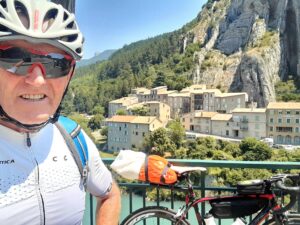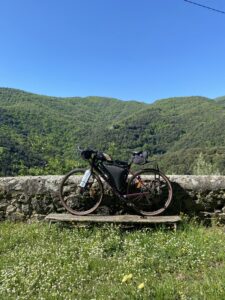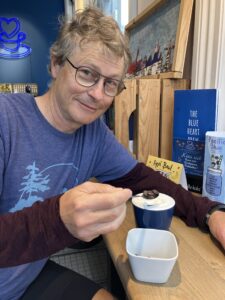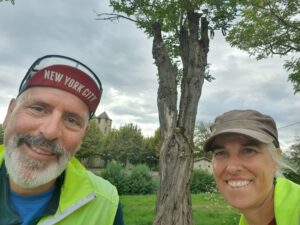Contributor: Caroline Burrows
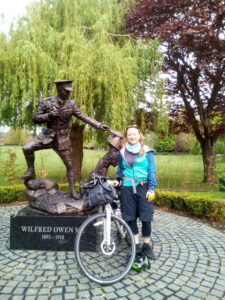 Wilfred Owen’s World War I poetry is a passion of mine, so after discovering there were some Wilfred locations in the northwest of England, I set off on a mini cycling adventure, a Wilfred Owen odyssey.
Wilfred Owen’s World War I poetry is a passion of mine, so after discovering there were some Wilfred locations in the northwest of England, I set off on a mini cycling adventure, a Wilfred Owen odyssey.
In early May, I cycled from near Blackpool, fifty miles south, to Liverpool. I headed past the Fylde district’s lamb-filled farmlands until having to face Preston’s busy city roads. Once through but still on a major A-road, I passed a World War II Centurion tank parked on the roadside with a sign welcoming me to Leyland, where those tanks used to be manufactured.
I got back on country roads until the suburbs of Liverpool. It was a relief to find some dedicated cycle lanes and ride to a fine finish at the Albert Docks with its waterside museums, cafés, and a large statue of the Beatles.
The following day, I left my bike to get a train under the River Mersey to Birkenhead, where Wilfred lived from age seven. First, I found Jim Whelan’s statue commissioned for the centenary of the end of World War I, which depicts a soldier slumped with his head in his hands. Its plaque displays Owen’s poem ‘Futility’, about a soldier from a farm who’s frozen to death overnight in the trenches. It was Owen’s anger at the propaganda of war that was the subject of his poetry, in which he aimed to communicate the reality of trench warfare.
Round the corner was the Wilfred Owen Story Museum (it’s since moved location a few miles away), run by a musician who’d attended Birkenhead Institute, Wilfred’s school. It was filled with artifacts: photos of Wilfred with his siblings and as a boy dressed up as a soldier, and an advert for local Sunlight Soap showed an example of War propaganda: ‘The cleanest fighters in the world.’ A gas mask brought to mind Wilfred’s poem ‘Dulce et Decorum Est.’ His Latin title was a protest and quote from a poem taught in schools, which translates as: ‘It is Sweet and Brave to Die for One’s Country.’ Instead, Owen’s poem describes the horrific effects of a mustard gas attack on a soldier unable to get his mask on.
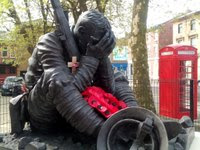
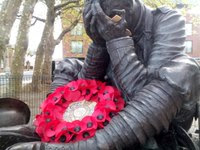
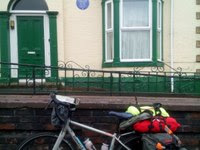
The next day, with my bike, I crossed the Mersey again, ready to pedal fifty miles to Oswestry, Wilfred’s birthplace. I cycled past his Birkenhead home on my way out of the urban landscape, then onto forested back roads, which abruptly ended at a dual carriageway. At a junction, like a mirage, was ‘Eureka’, a cycling café. I went in for a coffee and local knowledge on how to survive cycling into Chester. As soon as I pulled my map out, I was surrounded. Friendly cyclists inundated me with options, with one going my way. Cycling on the Millennium Greenway, Roy pointed out a cemetery and said, ‘Biggest population in Chester.’ It was filled with rows of Commonwealth war graves.
After seeing Chester’s medieval walls, I was back on country lanes. It had been sunny, but for the remainder, my waterproofs were fully tested. I passed Hillfort, a settlement since the Iron Age, near Wilfred’s 1916 army training camp. He wrote a poem called ‘Storm’ around this time. However, enduring my own weather front, all I could think about was getting to my Warmshowers’ hosts.
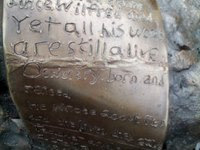
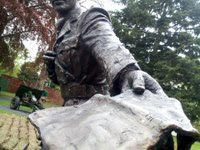
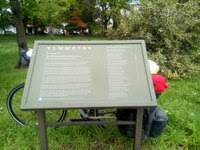
Duncan and Olly were keen cyclists, Green campaigners, and involved in the local arts. It wasn’t long before I’d recovered from the soggy cycling and was made welcome with conversation over a hearty dinner. They’d agreed to let me stay a second night so I could see the town, and so I made dinner the following evening to thank them.
Wilfred was born in Oswestry in 1893, and a leaflet showed it packed with associated places. First, was Cae Glas Park. Tim Turner’s 2018 statue depicted Wilfred in uniform holding out a stream of poems, which included local schoolchildren’s words cast in their handwriting.
St Oswald’s Churchyard, where Wilfred’s parents were married, had a plaque with the poems ‘Futility’ and ‘Anthem for Doomed Youth.’ Oswestry’s Visitor Centre displayed his letters to his mum. His birthplace at Plas Wilmot had a blue plaque. This was the family home until 1900, when Wilfred’s grandfather died, leaving them financially ruined, resulting in their move to Birkenhead. Oswestry’s old train station was where Wilfred’s dad worked, and there was a Wilfred Owen Memorial Park.
The library apparently had a display, but I couldn’t find it. When I asked the librarian, Lou produced four thick ring binders from a cupboard. I sat and pored over the articles. Lou returned to show me a photo. The town had organised a Bake-Off, and she’d made a Wilfred Owen themed Poppy and Lemon Seed cake!
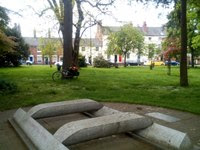
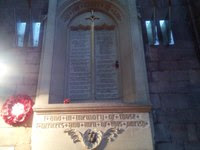
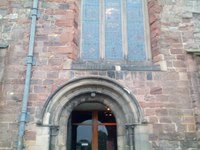
Back on my pilgrimage, I cycled a shorter day’s ride along quiet lanes towards Shrewsbury, where Wilfred’s family moved in 1907 after his dad received a promotion. I arrived armed with another Wilfred leaflet. Outside Shrewsbury Abbey, a board displayed ‘Strange Meeting,’ a poem about a soldier in the trenches of hell who meets a soldier he’s killed and realises he’s also dead. In the grounds, commemorating the centenary of Wilfred’s birth, was a 1993 sculpture called ‘Symmetry’ by Paul De Monchaux. It represented the pontoon Owen was helping construct across the Sambre Canal in France when he was killed.
I found even more Wilfred houses to rest my bike against. At one, I asked a passer-by to take my photo. I’d stopped another Wilfred fan. ‘You must go to Oxford University’s library; they have lots of Owen’s letters there,’ he said.
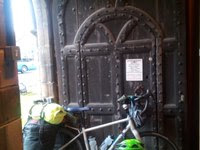
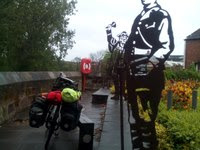
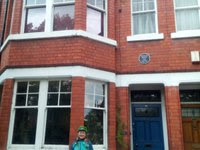
I circled back to the Abbey. Inside, a tablet on the wall read: ‘In memory of those officers and men of this parish who fell in the Great War.’ Its list included: Lieutenant W.E.S. Owen M.C. Manchester Regiment. Wilfred died aged twenty-five on 4th November 1918, one week before the Armistice. His nephew Peter Owen said that on 11th November, when Shrewsbury Abbey’s bells were ringing war’s end, the telegram arrived informing Wilfred’s parents he’d been killed.
At my journey’s end, I cycled away somewhat downcast, but on reflection realised I’d discovered many happy aspects to the life of the poignant WWI poet. And on my adventure, I’d I met a wonderful amount of fellow Wilfred Owen enthusiasts.
Find Caroline Burrows on social media at her handle @VerseCycle :


